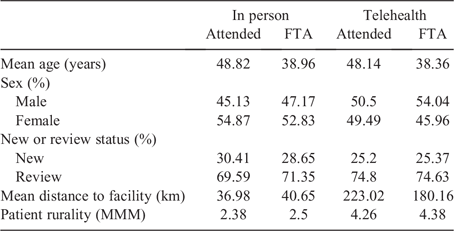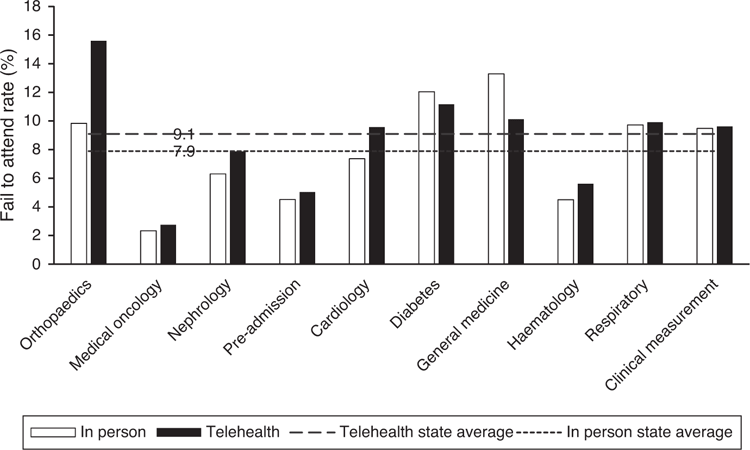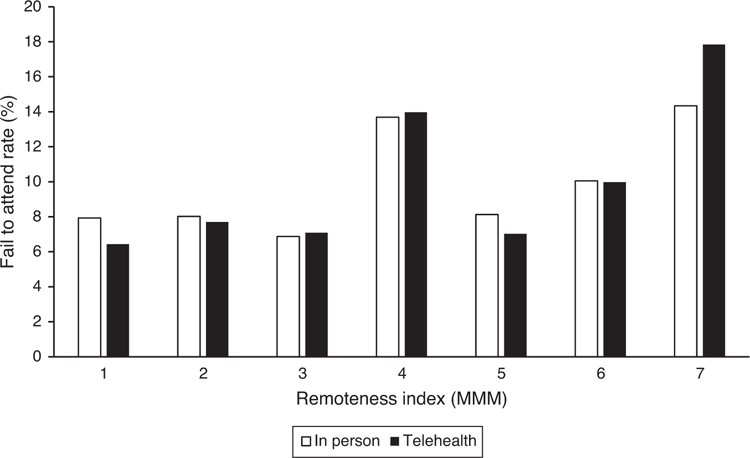No observed reduction of non-attendance rate in telehealth models of care
E. P. Greenup A C , D. Best A , M. Page A and B. Potts BA Clinical Excellence Queensland, Queensland Health, Level 2, 15 Butterfield Street, Herston, Qld 4006, Australia. Email: daniel.best@health.qld.gov.au; matthew.page2@health.qld.gov.au
B Menzies School of Health Research, Brisbane, Qld 4000, Australia. Email: boyd.potts@menzies.edu.au
C Corresponding author. Email: phil.greenup@health.qld.gov.au
Australian Health Review 44(5) 657-660 https://doi.org/10.1071/AH19127
Submitted: 1 February 2019 Accepted: 11 July 2019 Published: 22 October 2019
Journal Compilation © AHHA 2020 Open Access CC BY-NC-ND
Abstract
Objective This study investigated the provision of public specialist out-patient services in Queensland delivered in traditional hospital settings (in person) or through a two-way synchronous videoconferencing session (telehealth). Rates of attendance between these delivery methods were compared to detect any difference in rates of non-attendance among patients.
Methods An extract of all specialist out-patient appointments reported in Queensland Health’s corporate patient administration systems between 1 July 2017 and 30 June 2018 was obtained (n = 2 921 702). Variables including how the service was delivered and whether the patient attended were captured for each event.
Results No reduction in non-attendance was observed in the telehealth patient group (9.1%) compared with in-person service delivery (9.1% vs 7.9% respectively;  = 113.56, P < 0.001, relative risk = 1.15).
= 113.56, P < 0.001, relative risk = 1.15).
Discussion The study found no evidence that telehealth is effective at reducing rates of non-attendance in a specialist out-patient setting. This supports existing findings that most non-attendance is the result of forgetfulness or confusion with appointment details, to which telehealth appointments are also vulnerable.
What is known about the topic? Non-attendance of out-patient appointments remains a persistent and costly problem for public and private providers of health services. Forgetting or being confused about appointment details are the most commonly reported reasons for patient non-attendance.
What does this paper add? Telehealth models of care are increasingly being offered by health service providers, reducing travel requirements to all patients, particularly those in regional and remote settings. However, telehealth models of care do not address the most common reasons for patient non-attendance and telehealth patients are not less likely to miss their appointments.
What are the implications for practitioners? Suggestions that telehealth models of care can reduce rates of non-attendance should be treated with caution by health service administrators and clinicians. More timely appointment reminders and easier processes to cancel or reschedule appointments remain the most effective techniques for reducing non-attendance.
Introduction
A patient failing to attend a scheduled appointment is an undesirable occurrence for a health service provider. Valuable health resources are underutilised and efforts to reduce clinic waiting lists are hindered. In the search for solutions to this problem, it is often reported that telehealth models of care can reduce rates of non-attendance.1,2 This claim is easily accepted because it is intuitive that, by reducing the burden of travel, attending is easier and a patient is more likely to make their appointment.
In the 2017–18 financial year, Queensland Health delivered 52 743 specialist out-patient appointments using telehealth models of care. We considered this a sufficiently large volume to compare rates of attendance of these appointments with traditional (in person) events and to determine whether rates of non-attendance differed between these two delivery methods.
Methods
An extract of all specialist out-patient appointments reported in Queensland Health’s corporate patient administration systems between 1 July 2017 and 30 June 2018 was obtained (n = 2 921 702). Variables collected included hospital location, patient residential address (suburb and postcode only), a unique identifier and clinic descriptions; in addition, how the service was delivered and whether the patient attended were captured for each event. Services that were delivered through methods other than in person or telehealth (i.e. telephone) were considered out of scope and removed from the study. Appointments that were rescheduled or cancelled were omitted to focus the study on whether an appointment was attended or not. Patients reporting a residential address outside of Queensland were also removed because the transient nature of this group can skew inquiries of non-attendance. A comparison of patient demographic information by delivery method is presented in Table 1.

|
Results
Attendance averages by delivery method for the 2017–18 financial year, including a comparison of in-person and telehealth attendance rates for the 10 largest telehealth specialties are shown in Fig. 1. A similar comparison, grouped by the remoteness index of the patient’s residential address, is shown in Fig. 2. In Queensland during the 2017–18 financial year, the probability of non-attendance by a patient with a scheduled telehealth appointment was 15% higher than for a patient with an equivalent in-person appointment ( = 113.56, P < 0.001, relative risk = 1.15).
= 113.56, P < 0.001, relative risk = 1.15).

|

|
Discussion
Reports of a reduction in non-attendance attributed to telehealth models of care1,2 are unsubstantiated by the dataset used in this study. Previous investigations of non-attendance converged on patient behaviour, such as forgetting or being confused with appointment details, as the most common explanation.3–14 Telehealth models of care reduce the distance a patient is required to travel, but they do not remove these potential points of failure, as the results of this study appear to confirm.
Interventions demonstrating success in reducing non-attendance have typically involved improving interactions with patients, such as appointment reminder services, simplified cancellation or rescheduling processes and reducing the practice of booking appointments far in advance.15–17 Evidence that reducing travel requirements improves attendance is limited to isolated studies.18,19 In these examples, additional factors, such as increased promotion, communication and supplementing telehealth clinics with the provision of services in more convenient, non-clinical settings, are likely to have been greater contributors to the observations. The surprising results of a recent study in which free rideshare trips were provided to a largely urban-based population in order to make attendance at a primary health clinic easier were that participants were no less likely to increase attendance than those who arranged the journey themselves.20 One explanation for this is that travel represented a relatively minor contributor to non-attendance among the participants of that study.
When a patient is required to attend a medical appointment, a period of time beforehand is required to travel to the facility providing the treatment. In the case of patients living in rural and remote locations, this time could amount to many hours, if not several days. When a patient receives a health service using a telehealth model of care at their local facility as an alternative to travelling further to the hospital where their specialist is located, the time needed for the patient to prepare for the appointment is reduced. Service providers have time that would have otherwise been lost during travel to confirm appointment details with patients and avoid situations where this reminder occurs when they are simply too far away to make their appointment on time. This may provide an opportunity for telehealth models of care to contribute to efforts in reducing rates of non-attendance. Where communication with patients is insufficient or unclear, telehealth models of care cannot compensate and are no less likely to contribute to rates of non-attendance by patients.
Several patterns were noted in this study, including: (1) the mean age of non-attendances for both in-person and telehealth appointments was lower than the mean age of those attending appointments; and (2) variation of attendance rates between different specialities is greater than the difference in attendance between in-person and telehealth appointments for the same speciality. Further investigation of these observations may be useful in better understanding non-attendance and developing strategies to reduce their effects.
Conclusion
Large variations in travel requirements to receive health services exist in Queensland. Despite this, no correlation between travel reduction and reductions in non-attendance was observed in this study. Non-attendance may be a poor measure of travel burden, as plausible as it may seem. This finding supports most available evidence that human factors, including forgetfulness, confusion or anxiety towards a scheduled appointment, and not travel requirements, contribute most significantly to rates of non-attendance. It is likely that telehealth models of care have a role to play in reducing non-attendance but, in the absence of clear communication, timely and appropriate appointment reminders and the ability to easily cancel or reschedule appointments, telehealth appointments will remain as susceptible to non-attendance as traditional appointments are.
Competing interests
The authors declare no conflicts of interest.
Acknowledgements
This research did not receive any specific funding.
References
[1] Telstra Health. Virtual clinical services. 2019. Available at: https://www.telstrahealth.com/home/products/clinical-services-doctor-specialist-allied.html [verified 8 October 2019].[2] McDonald, K. NT telehealth trial has saved time, money and improved access to care. Pulse+IT 25 February 2016. Available at: https://www.pulseitmagazine.com.au/news/australian-ehealth/2928-nt-telehealth-trial-has-saved-time-money-and-improved-access-to-care [verified 3 October 2019].
[3] Collins J, Santamaria N, Clayton L. Why outpatients fail to attend their scheduled appointments: a prospective comparison of differences between attenders and non-attenders. Aust Health Rev 2003; 26 52–63.
| Why outpatients fail to attend their scheduled appointments: a prospective comparison of differences between attenders and non-attenders.Crossref | GoogleScholarGoogle Scholar | 15485374PubMed |
[4] Stone CA, Palmer JH, Saxby PJ, Devaraj VS. Reducing non-attendance at outpatient clinics. J R Soc Med 1999; 92 114–18.
| Reducing non-attendance at outpatient clinics.Crossref | GoogleScholarGoogle Scholar | 10396253PubMed |
[5] Henderson R. Encouraging attendance at outpatient appointments: can we do more? Scott Med J 2008; 53 9–12.
| Encouraging attendance at outpatient appointments: can we do more?Crossref | GoogleScholarGoogle Scholar | 18422203PubMed |
[6] Roberts K, Callanan I, Tubridy N. Failure to attend out-patient clinics: is it in our DNA? Int J Health Care Qual Assur 2011; 24 406–12.
| Failure to attend out-patient clinics: is it in our DNA?Crossref | GoogleScholarGoogle Scholar | 21916092PubMed |
[7] Kosmider S, Shedda S, Jones IT, McLaughlin S, Gibbs P. Predictors of clinic non-attendance: opportunities to improve patient outcomes in colorectal cancer. Intern Med J 2010; 40 757–63.
| Predictors of clinic non-attendance: opportunities to improve patient outcomes in colorectal cancer.Crossref | GoogleScholarGoogle Scholar | 19460064PubMed |
[8] Goldbart AD, Dreiher J, Vardy DA, Alkrinawi S, Cohen AD. Nonattendance in pediatric pulmonary clinics: an ambulatory survey. BMC Pulm Med 2009; 9 12
| Nonattendance in pediatric pulmonary clinics: an ambulatory survey.Crossref | GoogleScholarGoogle Scholar | 19366453PubMed |
[9] Moore CG, Wilson-Witherspoon P, Probst JC. Time and money: effects of no-shows at a family practice residency clinic. Fam Med 2001; 33 522–7.
| 11456244PubMed |
[10] Wilkinson J, Daly M. Reasons for non-attendance: audit findings from a nurse-led clinic. J Prim Health Care 2012; 4 39–44.
| Reasons for non-attendance: audit findings from a nurse-led clinic.Crossref | GoogleScholarGoogle Scholar | 22377548PubMed |
[11] Murdock A, Rodgers C, Lindsay H, Tham TCK. Why do patients not keep their appointments? Prospective study in a gastroenterology outpatient clinic. J R Soc Med 2002; 95 284–6.
| Why do patients not keep their appointments? Prospective study in a gastroenterology outpatient clinic.Crossref | GoogleScholarGoogle Scholar | 12042374PubMed |
[12] Koppens JM, Dai S, Mora J. Factors related to non-attendance in a public eye clinic. Clin Exp Ophthalmol 2005; 33 553–4.
| Factors related to non-attendance in a public eye clinic.Crossref | GoogleScholarGoogle Scholar | 16181296PubMed |
[13] Cusini M, Auxilia F, Trevisan V, Visconti U, Castaldi S. A telephone survey on the reasons for non-attendance in a dermatological clinic. G Ital Dermatol Venereol 2008; 143 353–7.
| 19169207PubMed |
[14] Kaplan-Lewis E, Percac-Lima S. No-show to primary care appointments: why patients do not come. J Prim Care Community Health 2013; 4 251–5.
| No-show to primary care appointments: why patients do not come.Crossref | GoogleScholarGoogle Scholar | 24327664PubMed |
[15] Geraghty M, Glynn F, Amin M, Kinsella J. Patient mobile telephone ‘text’ reminder: a novel way to reduce non-attendance at the ENT out-patient clinic. J Laryngol Otol 2008; 122 296–8.
| Patient mobile telephone ‘text’ reminder: a novel way to reduce non-attendance at the ENT out-patient clinic.Crossref | GoogleScholarGoogle Scholar | 17470313PubMed |
[16] Liew SM, Tong SF, Lee VKM, Ng CJ, Leong KC, Teng CL. Text messaging reminders to reduce non-attendance in chronic disease follow-up: a clinical trial. Br J Gen Pract 2009; 59 916–20.
| Text messaging reminders to reduce non-attendance in chronic disease follow-up: a clinical trial.Crossref | GoogleScholarGoogle Scholar | 19712544PubMed |
[17] Lee CS, McCormick PA. Telephone reminders to reduce non-attendance rate for endoscopy. J R Soc Med 2003; 96 547–8.
| Telephone reminders to reduce non-attendance rate for endoscopy.Crossref | GoogleScholarGoogle Scholar | 14594962PubMed |
[18] Caffery LJ, Bradford NK, Wickramasinghe SI, Hayman N, Smith AC. Outcomes of using telehealth for the provision of healthcare to Aboriginal and Torres Strait Islander people: a systematic review. Aust N Z J Public Health 2017; 41 48–53.
| Outcomes of using telehealth for the provision of healthcare to Aboriginal and Torres Strait Islander people: a systematic review.Crossref | GoogleScholarGoogle Scholar | 27868300PubMed |
[19] Smith AC, Armfield NR, Wu W, Brown CA, Mickan B, Perry C. Changes in paediatric hospital ENT service utilisation following the implementation of a mobile, Indigenous health screening service. J Telemed Telecare 2013; 19 397–400.
| Changes in paediatric hospital ENT service utilisation following the implementation of a mobile, Indigenous health screening service.Crossref | GoogleScholarGoogle Scholar | 24218353PubMed |
[20] Chaiyachati KH, Hubbard RA, Yeager A, Mugo B, Lopez S, Asch E, Shi C, Shea JA, Rosin R, Grande D. Association of rideshare-based transportation services and missed primary care appointments. JAMA Intern Med. 2018; 178 383–9.
| Association of rideshare-based transportation services and missed primary care appointments.Crossref | GoogleScholarGoogle Scholar | 29404572PubMed |


